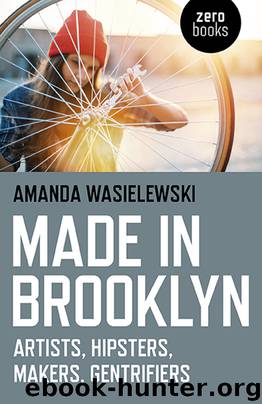Made in Brooklyn by Amanda Wasielewski

Author:Amanda Wasielewski [Wasielewski, Amanda]
Language: eng
Format: epub
ISBN: 978-1-78535-659-9
Publisher: John Hunt (NBN)
Published: 2018-06-28T16:00:00+00:00
Loft Living
Sharon Zukin’s book Loft Living describes a fusion of bohemian and bourgeois culture that David Brooks would later label “bobo,” a new manifestation of the middle class that arose in the latter half of the twentieth century where bohemian values are assimilated into capitalist consumption.57 Like Barbrook and Cameron before him, Brooks’ playful yet celebratory book, Bobos in Paradise, finds that the mixing of counterculture radicalism and neoliberal (or bourgeois) politics have produced a powerful social hybrid. Zukin’s analysis of SoHo was truly groundbreaking in identifying and tracing the changing values of those most prone to gentrify neighborhoods. The book is, however, often heavily nostalgic for a past industrial order and urban working class, resulting in oversimplification of oppositional forces within the city. Zukin argues that there was a concerted effort and long-term plan to deindustrialize city centers, repeatedly implying that a unification of government forces and “patrician” elite of the city consciously conspired to eradicate industrial manufacturing throughout the twentieth century. No explanation is given as to why city elites may have wanted so desperately to remake the urban fabric. Other factors that may have come into play such as increasingly globalized markets with access to foreign labor, Cold War politics and the threat of nuclear attack after the Second World War, and urbanist rhetoric around light, air and open space (which denounced toxic industrial works in city centers or near residential dwellings) are left unaddressed. Nevertheless, Zukin makes a compelling case for the rebranding of artists as productive members of the workforce after their instrumentalization in the WPA projects of the 1930s. She states, “Far more significant was the regularization of their employment as artists, which enabled them for the first time in history to make a living off a totally self-defined art. The state played a crucial role in this transformation.”58 Zukin describes the ways in which “artist” is suddenly a viable middle-class career choice in the 1960s. As the market for contemporary art expands, artists become college-educated professionals with the potential to live off of their autonomous artistic creation.59
The main difference, then, between Zukin’s assessment of SoHo and the urban change happening in Morgantown is the presence of government intervention. Zukin sees government intervention as instrumental in changing the nature of artists’ work – from something that is about producing for a client or potential buyer to something that is essentially only about self-actualization and freedom of creation. Describing the sudden vogue for production-as-hobby, she states, “the arts-and-crafts movement of the 1970s also shows how deeply art has been incorporated into many middle-class patterns of consumption.”60 This emphasis on craft is an important precursor to the Maker Movement, and Zukin laments the fact that production is taken over by the middle class as hobby and lifestyle. One of the more telling examples she provides is how loft residents began to implement “professional” kitchen equipment into their residential space, solidifying this fusion of consumption of formerly productive domains.61 This trend in professionalization of equipment for hobby or leisure purposes continued unabated since the time the book was published in 1982.
Download
This site does not store any files on its server. We only index and link to content provided by other sites. Please contact the content providers to delete copyright contents if any and email us, we'll remove relevant links or contents immediately.
| Anthropology | Archaeology |
| Philosophy | Politics & Government |
| Social Sciences | Sociology |
| Women's Studies |
Nudge - Improving Decisions about Health, Wealth, and Happiness by Thaler Sunstein(7657)
iGen by Jean M. Twenge(5385)
The Fire Next Time by James Baldwin(5382)
Adulting by Kelly Williams Brown(4532)
The Sports Rules Book by Human Kinetics(4342)
The Hacking of the American Mind by Robert H. Lustig(4338)
The Ethical Slut by Janet W. Hardy(4212)
Captivate by Vanessa Van Edwards(3815)
Mummy Knew by Lisa James(3655)
In a Sunburned Country by Bill Bryson(3507)
The Worm at the Core by Sheldon Solomon(3450)
Ants Among Elephants by Sujatha Gidla(3440)
The 48 laws of power by Robert Greene & Joost Elffers(3147)
Suicide: A Study in Sociology by Emile Durkheim(2989)
The Slow Fix: Solve Problems, Work Smarter, and Live Better In a World Addicted to Speed by Carl Honore(2975)
The Tipping Point by Malcolm Gladwell(2870)
Humans of New York by Brandon Stanton(2847)
Handbook of Forensic Sociology and Psychology by Stephen J. Morewitz & Mark L. Goldstein(2677)
The Happy Hooker by Xaviera Hollander(2672)
